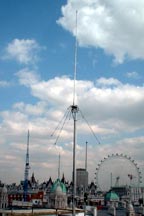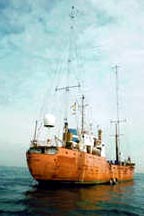Thursday 3 November, 2005, 10:36 - Pirate/Clandestine
Any illegal radio transmission runs the risk of being tracked down by the relevant authorities who use sophisticated equipment to monitor the spectrum for unlicensed transmissions. Such equipment is capable of pin-pointing the location of a given transmitter to within a few hundred metres in under a second and together with mobile and hand-held equipment can track down an illegal transmitter with no difficulty.  This is easier at VHF and UHF frequencies than it is at frequencies below 30 MHz, as the line-of-sight nature of propagation at these higher frequencies simplifies the tracking operation. At frequencies below about 30 MHz, the accuracy of most of the equipment begins to fall and large, fixed stations are needed to produce any level of detail. Such stations do exist though, and given the fact that MF and HF signals travel large distances, a few of these fixed monitoring stations in two or three neighbouring countries can work together to identify the location of an illegal transmitter (which the mobile teams can then home in on).
This is easier at VHF and UHF frequencies than it is at frequencies below 30 MHz, as the line-of-sight nature of propagation at these higher frequencies simplifies the tracking operation. At frequencies below about 30 MHz, the accuracy of most of the equipment begins to fall and large, fixed stations are needed to produce any level of detail. Such stations do exist though, and given the fact that MF and HF signals travel large distances, a few of these fixed monitoring stations in two or three neighbouring countries can work together to identify the location of an illegal transmitter (which the mobile teams can then home in on).It amazes me, therefore, that there are so many pirate radio stations who continue to operate 24 hours per day, 7 days per week. A quick tune across the FM dial in London at lunchtime in the middle of the week yielded the following stations happily pumping out pumping tunes:
87.9 Shine 879
91.8 Passion FM
93.8 Vibes FM
95.4 Roots FM
97.9 Bassline FM
101.2 Unique
101.9 The Beat
Now it's fair to say that many of these stations are regularly closed down by the authorities, but have sufficient funding and expertise to be back on the air in short shrift. They also tend to use a complicated set of links to connect the studio to the transmitter site such that if the transmitter site is identified, the studio location (where the more expensive equipment and the presenter are located) remains secret. A studio hit on a pirate costs much more to recover from and often leads to prosecution.
It's also fair to say that these staitons have, on the whole, managed to settle on frequencies that tend to minimise the amount of interference they cause to the legal stations. Many pirate stations in London operate only 200 kHz away from legal stations which is far too close to prevent interference (the reasons for which are something to talk about on another day perhaps), but all these stations sit sufficiently far enough away from legal stations (typically a minimum of 400 kHz) that the interference they cause is relatively small. The fact that they are all in mono also improves the situation (and has the bonus for the pirate station that their coverage area is increased). Nonetheless, these stations do cause interference, especially close to the transmitters concerned where the sheer power of the illegal signal overwhealms nearby receivers and the authorities tend to act more virulently where a complaint of interference has been received.
However these aren't the only long-term illegal transmissions that can be found. A recent scan of the short-wave broadcast bands brought to my attention 'Laser Hot Hits' - a pirate station that broadcasts 24/7 on a number of short-wave frequencies (try 4025, 6219, 6285, 7460 and 9385 kHz, though the 7460 kHz signal is often wiped out by a strong BBC DRM transmission from Kvitsoy in Norway on 7465 kHz in the afternoons). What makes this more intriguing than the London pirate situation is that many of the frequencies they are using will cause significant interference not, in this case, to other broadcasters, but to maritime, aeronautical and defence spectrum users, yet their transmissions have remained on-air, seemingly unchecked for many months now. In particular, the 6219 kHz transmission will directly interfere with safety-of-life, emergency maritime communications on 6215 kHz.
So how come they are still on-air? One possibility is that their transmitter site location (not needing to be near to the listeners due to the propagation at HF) is somewhere so remote that the authorities either can't, or can't be bothered, to get to it. A persistant pirate of the late 1980's, 'Radio Fax' used to transmit from a rural location in Ireland and the Irish authorities who have always been much more tolerant to pirate transmissions than many other countries, were very sluggish to step into action. Maybe Laser Hot Hits' transmitter site is on one of the mountains of the Netherlands, which the local mountain rescue teams can't reach! Wherever it is (or they are - there is no reason to suspect that all the frequencies are transmitted from the same site) they have obviously escaped scrutiny so far.
 So what conclusions can we draw from this? Perhaps those in power accept 'pirate radio' as a problem that will never go away and for stations who act responsibly turn a blind-eye (remember that pirate radio has had a greater impact on the shape of the UK radio industry than possibly any other factor, and even has a major impact today). Perhaps they do not have the resources to track down every station and concentrate on those who cause the biggest sores (e.g. those with outspoken political views or whose transmitting equipment is of low quality and is causing lots of interference). Perhaps they wait for compliants to be raised before tackling the problem. Whatever the reason, one must doff one's cap to those who continue to flout the law for our entertainment. Many are outlets for music which ordinary stations turn their back on but which has a large, cult, following. Some are there just for the fun of it (don't tell me that doing something naughty isn't at least a little bit thrilling...?) Gentlemen (and ladies), I raise my glass to you.
So what conclusions can we draw from this? Perhaps those in power accept 'pirate radio' as a problem that will never go away and for stations who act responsibly turn a blind-eye (remember that pirate radio has had a greater impact on the shape of the UK radio industry than possibly any other factor, and even has a major impact today). Perhaps they do not have the resources to track down every station and concentrate on those who cause the biggest sores (e.g. those with outspoken political views or whose transmitting equipment is of low quality and is causing lots of interference). Perhaps they wait for compliants to be raised before tackling the problem. Whatever the reason, one must doff one's cap to those who continue to flout the law for our entertainment. Many are outlets for music which ordinary stations turn their back on but which has a large, cult, following. Some are there just for the fun of it (don't tell me that doing something naughty isn't at least a little bit thrilling...?) Gentlemen (and ladies), I raise my glass to you.9 comments
( 2245 views )
| permalink
| 



 ( 2.9 / 20701 )
( 2.9 / 20701 )




 ( 2.9 / 20701 )
( 2.9 / 20701 )

